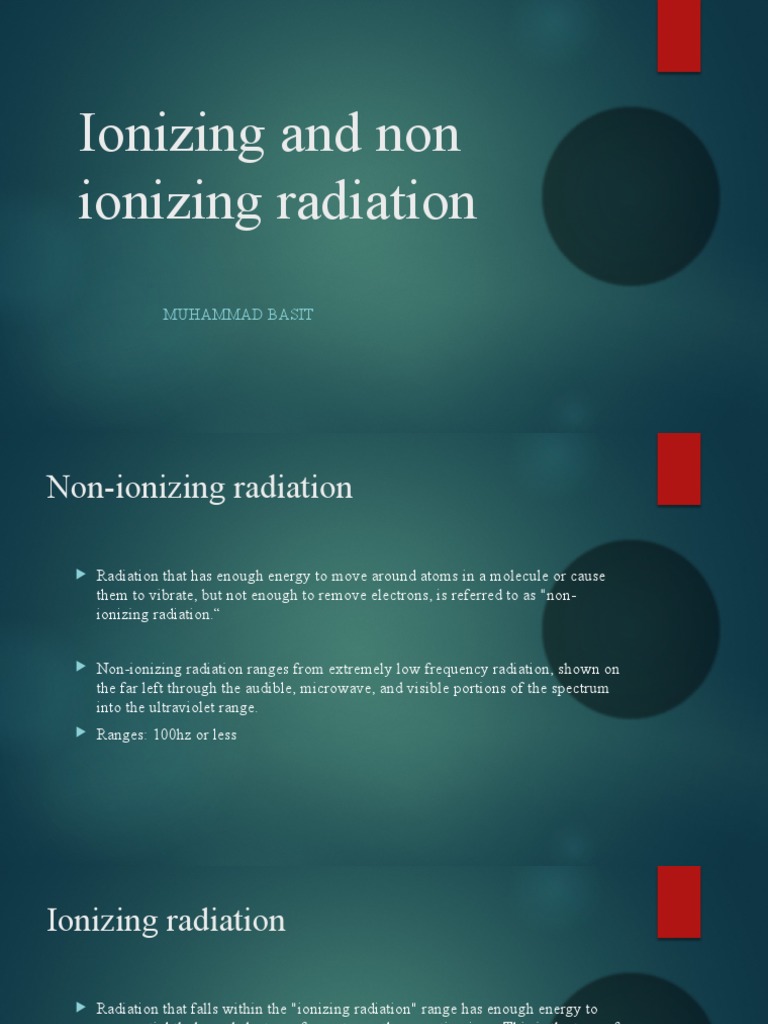Radiation, an omnipresent entity in the cosmos, can be categorized into two distinct types: ionizing and non-ionizing radiation. The pervasive nature of these types evokes substantial interest, given their profound implications for both natural and technological phenomena. This discussion aims to elucidate the defining characteristics of ionizing and non-ionizing radiation, explore their diverse applications, and unravel the health implications associated with each type.
Defining Radiation
Radiation can be defined as energy that is emitted in the form of particles or electromagnetic waves. At its core, the phenomenon is a result of atomic and molecular transitions that release energy. The classification into ionizing and non-ionizing radiation hinges on the energy levels of these emissions, specifically their ability to affect atomic structures.
Ionizing Radiation: Characteristics and Mechanisms
Ionizing radiation possesses sufficient energy to dislodge electrons from atoms or molecules, thereby creating charged particles or ions. This process can lead to a cascade of reactions within biological systems and materials, which subsequently highlights both potential benefits and risks. The primary types of ionizing radiation include alpha particles, beta particles, gamma rays, and X-rays, each exhibiting unique interactions with matter.
Alpha particles, consisting of two protons and two neutrons, emanate from heavy elements such as uranium and radium. Their relatively large mass and positive charge render them incapable of penetrating solid barriers but decidedly hazardous when ingested or inhaled. Conversely, beta particles, being high-energy, high-speed electrons or positrons, possess greater penetrative capabilities, which can result in biological damage at the cellular level.
Gamma rays and X-rays, the most penetrating forms of ionizing radiation, are electromagnetic waves with no mass and charge. They are often used in medical imaging and cancer treatment, entrusted with the compelling ability to destroy malignant cells. However, this potent tool carries a double-edged sword; excessive exposure can lead to serious health risks, including cancer induction and genetic mutation.
Non-Ionizing Radiation: Properties and Applications
Non-ionizing radiation, on the other hand, encompasses lower energy levels incapable of ionizing atoms. This includes a wide spectrum of electromagnetic radiation such as radio waves, microwaves, infrared radiation, and visible light. The primary distinction lies in their interaction with human biological tissues, where they do not cause ionization but can lead to heating effects at certain thresholds.
Radio waves, primarily used for communication and broadcasting, exemplify non-ionizing radiation’s extensive utility. At higher frequencies, microwaves are employed in cooking and various telecommunications applications, harnessing their ability to excite water molecules. Infrared radiation, omnipresent in thermal imaging, plays an essential role in heat detection and remote sensing technologies.
Moreover, visible light, a subset of non-ionizing radiation, occupies a significant place in both natural and artificial ecosystems. Its role in photosynthesis underpins the very foundation of life on Earth, while artificial lighting illuminates our environments, influencing our biological rhythms exponentially.
Health Implications: Risks and Benefits
The health implications of ionizing radiation are well-documented and often a cause for concern. While ionizing radiation is invaluable in medical therapies, its indiscriminate nature can induce significant adverse effects. Acutely, radiation sickness may manifest following exposure to high doses, presenting symptoms such as nausea, fatigue, and heightened susceptibility to infections. Long-term exposure, even at sub-lethal levels, can lead to oncogenesis, engendering genetic alterations that may be inherited.
Conversely, non-ionizing radiation is generally perceived as less harmful, though emerging studies suggest that certain types, particularly at high exposures, may carry latent risks. Prolonged exposure to high-intensity microwave radiation, for example, raises concerns regarding tissue heating and thermal damage. Nonetheless, the current consensus underscores that, under regulated conditions, non-ionizing radiation provides substantial benefits in numerous applications, from telecommunications to medical imaging.
The fascination with radiation, both ionizing and non-ionizing, stems from our growing dependency on technological advancements, alongside the continuous quest to understand the universe’s mysteries. The dichotomy found within radiation’s capabilities—a force that can heal and hurt—makes it an enthralling subject of study. It invites research into innovative solutions for minimizing risks while maximizing the applicable benefits of radiation in various fields.
Conclusion
In summary, ionizing and non-ionizing radiation serve as two fundamental components of the electromagnetic spectrum, each characterized by distinct energies and biological interactions. While one bears the formidable potential for both destructive and therapeutic applications, the other thrives within the realms of communication, cooking, and illumination. By deepening our understanding of these types of radiation, we not only unravel the intricacies of physical phenomena but also navigate the societal implications entwined with their use, crafting a path toward safer and more effective applications in the future.












